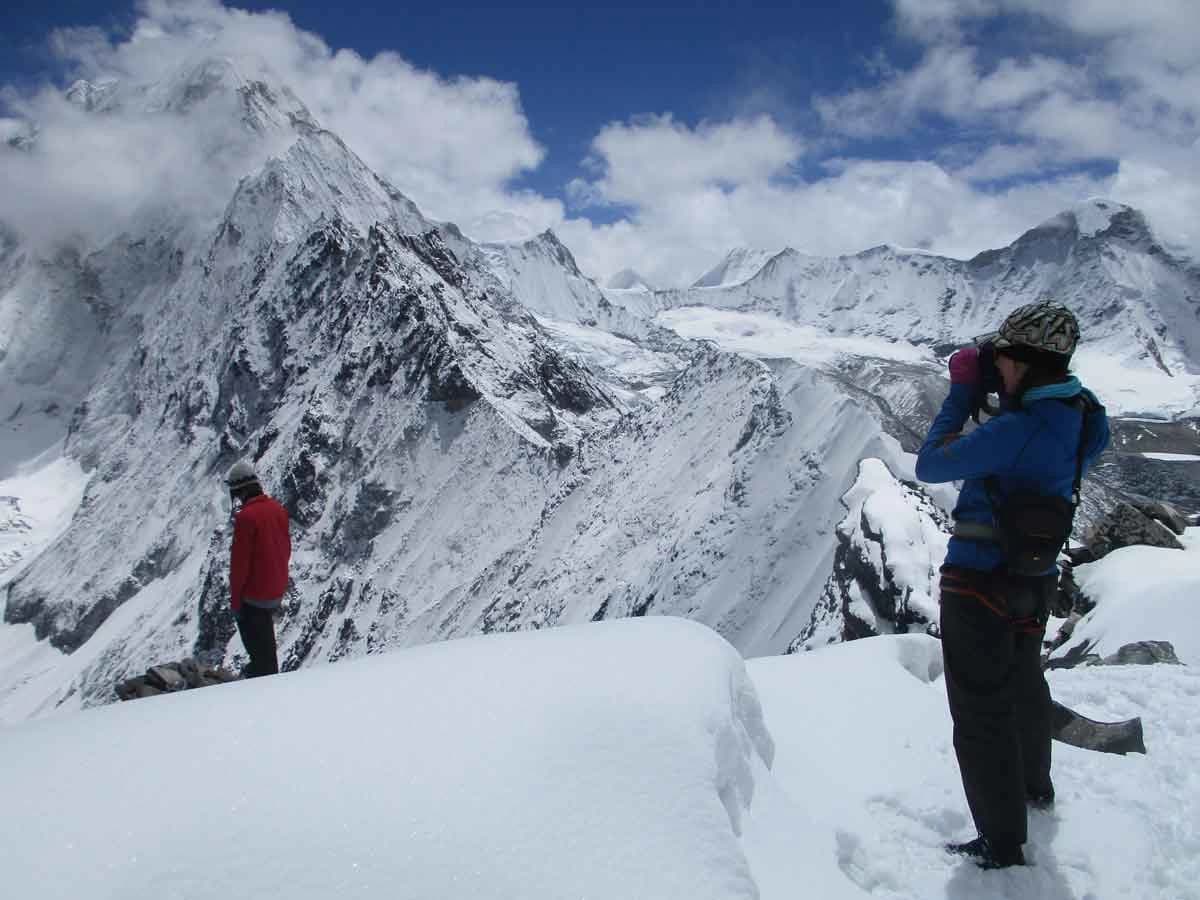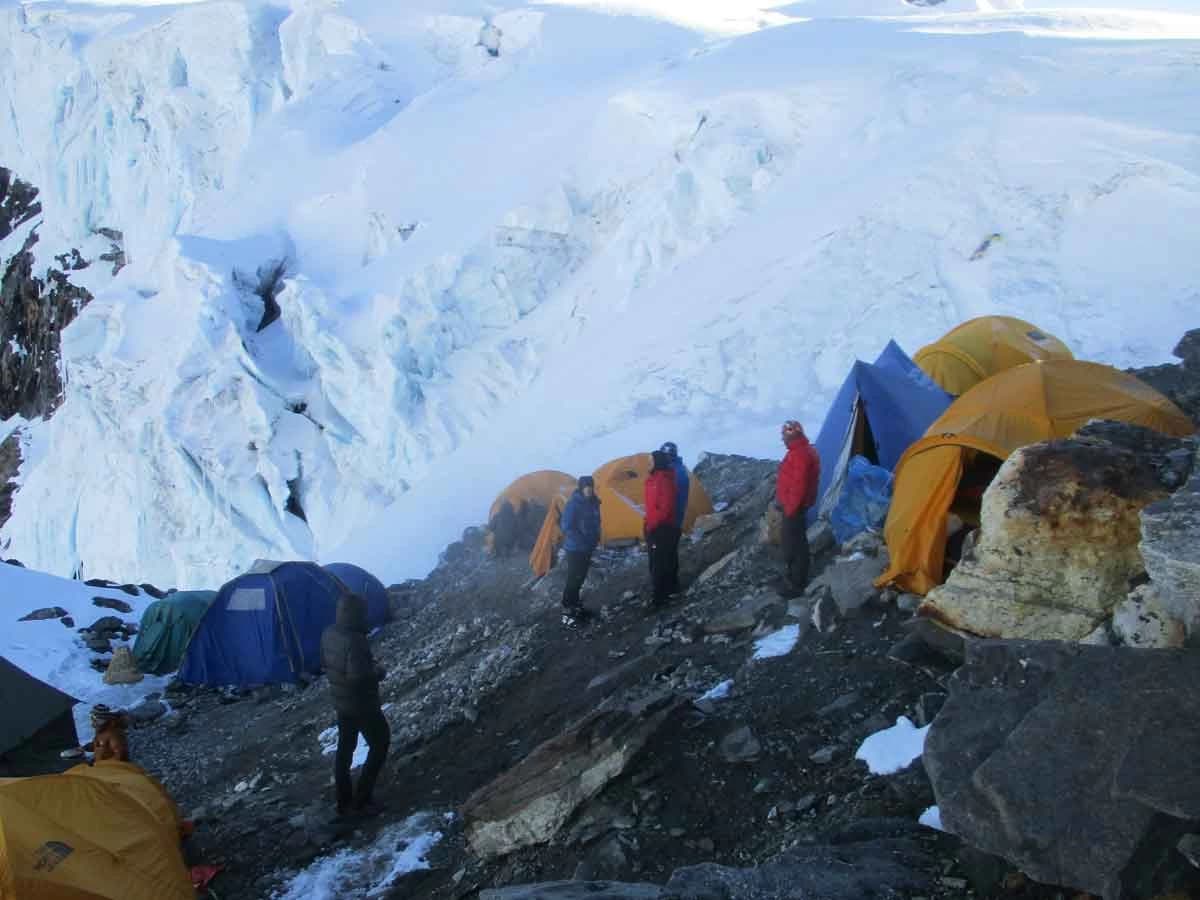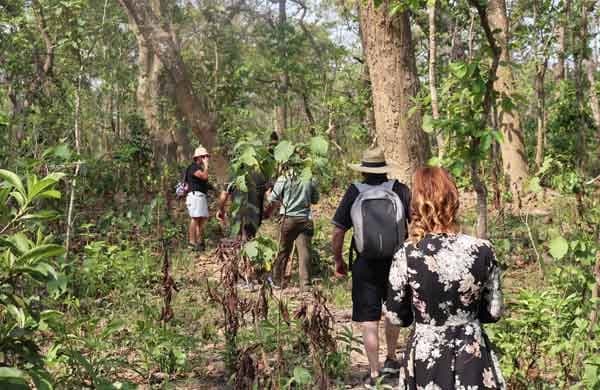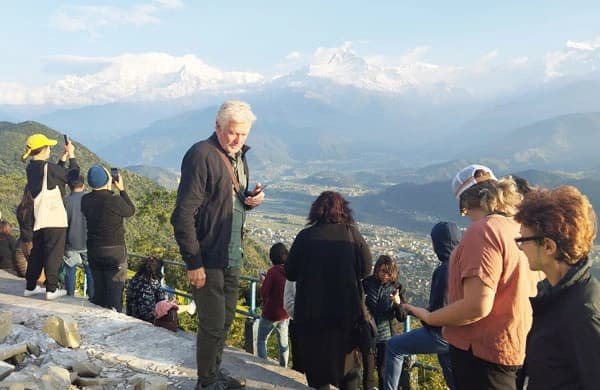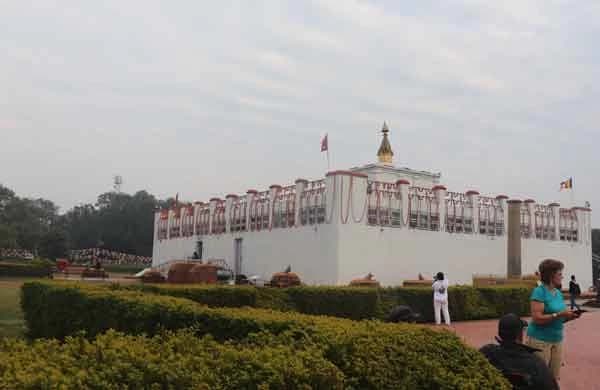Mera Peak is the tallest trekking peak in Nepal; trekking peaks in Nepal usually have less or no technical difficulties, which make them perfect for beginner climbers. However, it's important to note that the physical challenges of climbing a trekking peak like Mera are significant. This is not a journey to be taken lightly. Mera Peak Expedition will lead you to the summit of a Himalayan peak in Nepal, pushing your physical limits and rewarding you with a sense of accomplishment like no other.
Mera Peak Climbing - 19 Days
Mera Peak Climbing Overview
Scale the highest trekking peak in Nepal, Mera Peak climbing venture. Witness breathtaking landscapes and stunning views of the Himalayan mountains, including the five eight-thou sander mountains- Everest (8,849 m), Kanchenjunga (8,586 m), Lhotse (8,516 m), Cho Oyu (8,188 m), and Makalu (8,481 m).
Mera Peak is not just a mountain; it's a gateway to your first great conquest. Mera Peak has become a practice peak for professional mountaineers, who prefer to summit it to acclimatize before moving on to other technical mountains.
Among all the trekking peaks in Nepal, Mera has the most straightforward climbing route with a few small crevasses that our Sherpa guide will help you cross.
Rest assured, we safely guide numerous individuals to the top of Mera Peak every year. Our high success rate and extensive experience in the field make us a trusted and reliable Mera peak climbing Guide in Nepal.
We're with you every step of the way. From helping you prepare for the trip to providing support throughout your journey, our experienced team is committed to ensuring your safety and comfort. Book a seat for yourself and your loved ones through our Mera peak climbing package page.
Mera Peak Climbing Highlights
- Take a Thrilling Flight to Lukla
- Lukla is the starting point of Mera Peak climbing. A short and thrilling flight takes you to Lukla. During the flight, you can see aerial views of the Himalayan Mountains and landscape
- Cross Challenging Zatra La Pass
- On Mera peak climbing, you cross the rugged Zatra la Pass. The route to the top of the pass follows a windy, rugged path. On the day of crossing the pass, you wake up early and gradually ascend towards the pass
- From the top of the pass, you can see stunning views of Cho Oyu, Kongde Peak, Numbur Himal, Kusum Khangru, and many other Himalayan mountains
- Experience the Rich Culture and Unique Lifestyle of Sherpa
- While trekking, you spend many nights in different villages and encounter the daily lifestyle of Sherpas
- As you trek, you'll immerse yourself in the unique culture and practices of the Sherpas. From their daily lifestyle to their spiritual traditions, every encounter is a chance to deepen your understanding and connection with this vibrant community.
Mera Peak climbing attractions
There are many attractions during the Mera Peak Climbing and we have highlighted some of them as below.
Take a Thrilling Flight to Lukla
Lukla is the starting point of Mera Peak climbing. A short and thrilling flight takes you to Lukla. During the flight, you can see aerial views of the Himalayan Mountains and landscape.
Cross Challenging Zatra La Pass
Mera peak climbing, you cross the rugged Zatra la Pass. The route to the top of the pass follows a windy, rugged path. On the day of crossing the pass, you wake up early and gradually ascend towards the pass.
From the top of the pass, you can see stunning views of Cho Oyu, Kongde Peak, Numbur Himal, Kusum Khangru, and many other Himalayan mountains.
Experience the Rich Culture and Unique Lifestyle of Sherpa
While trekking, you spend many nights in different villages and encounter the daily lifestyle of Sherpas.
As you trek, you'll immerse yourself in the unique culture and practices of the Sherpas. From their daily lifestyle to their spiritual traditions, every encounter is a chance to deepen your understanding and connection with this vibrant community.
Adventurous and Tranquil trekking Trail
Even though the Mera Peak expedition traverses the Khumbu region, the trail is less crowded and tranquil. You must follow the trail opposite EBC Trek, which is comparatively less travelled.
The trail passes through small villages and dense forests. There are many ascends and descends, and it can get steep and rugged in a few parts.
Climb the Mera Peak
Reaching the Mera peak is the ultimate goal of the entire journey. The trail is adventurous and thrilling. Following your guide's lead, you gradually move towards the top of the peak.
During the climbing period, your team leader also briefs you on the proper use of gears and teaches you basic climbing skills.
Beautiful Landscape and Stunning Views of the Himalayan Mountains
Mera Peak Climbing offers beautiful landscapes and stunning views of the Himalayas. The gorgeous trail passes through picturesque villages, lovely streams, fine valleys, and moraines.
You get to see panoramic views of Mt. Everest (8,848 m), Mt. Makalu (8,481 m), Mt. Cho Oyu (8,201), Mt. Baruntse (7,162 m), Mt. Lhotse (8,516 m), Mt. Nuptse (7,861 m), Mt. Chamlang (7,319 m), and many other snow-capped peaks.
The trekking part during the Mera Peak Expediton
Per our Mera peak climbing itinerary, you will spend the initial part of the journey trekking through lush forests and remote Sherpa villages.
Before you make it to the Mera Base Camp, you will trek for five days to reach Khare and take an acclimatization day in the same village. From Lukla, you will be trekking east to the unspoiled Hinku Valley.
As most people go to Everest base camp from Lukla, the route we will follow during Mera Peak climbing is in a different direction and not crowded.
The trekking part immerses you because you witness and experience the simple mountain lifestyle. You also get to meet locals and know their traditions and culture.
Mera peak climbing route
The north face of Mera Peak is the standard route to climb this peak. The route is beginner-friendly, so avid climbers frequently approach it.
The climbing route crosses a high-altitude glacier. Therefore, we study the snow conditions before the expedition begins to ensure the trail's safety. The slopes do not go above 30 degrees.
On the way to Mera Base Camp, you will cross the Mera La Pass at 5,400 meters (17,717 feet). Above base camp, we will make Mera High Camp at 5,780 meters (18,964 ft).
The high camp will be on a rocky shelf behind a sizeable vertical rock. This area will protect us from falling rocks or avalanches.
Mera peak climbing pre-training
Our team leader will provide basic climbing training to boost your confidence. They will also brief you about all the circumstances you may encounter while approaching the summit and how to use the climbing gear.
You will also learn to fix ropes and use fix lines, which offers an excellent opportunity to learn to use climbing gear, such as crampons and ice axes. The pre-climbing training will be at Khare during the acclimatization day. Our Sherpa guides will fix the ropes wherever needed and provide you with full support on the way.
- Day 01: Arrive at Kathmandu airport and transfer to hotel
- Day 02: Full-day tour in Kathmandu
- Day 03: Fly to Lukla and trek to Paiya
- Day 04: Trek from Paiya to Panggom
- Day 05: Trek from Zatrabok to Kothe
- Day 06: Trek from Kothe to Thangnak
- Day 07: Trek from Thangnak to Khare
- Day 08: Rest day at Khare for Acclimatization
- Day 09: Trek from Khare to Mera base camp
- Day 10: Trek from base camp to Mera high camp
- Day 11: Summit Mera Peak and trek back to Khare
- Day 12: Spare day for a summit push in case of bad weather
- Day 13: Trek from Khare to Kothe
- Day 14: Trek from Kothe to Zatrabok
- Day 15: Trek from Zatrabok to Chutanga
- Day 16: Trek from Chutanga to Lukla
- Day 17: Fly from Lukla to Kathmandu and transfer to hotel
- Day 18: Extra/Buffer day in Kathmandu
- Day 19: Transfer to the international airport for your departure flight home
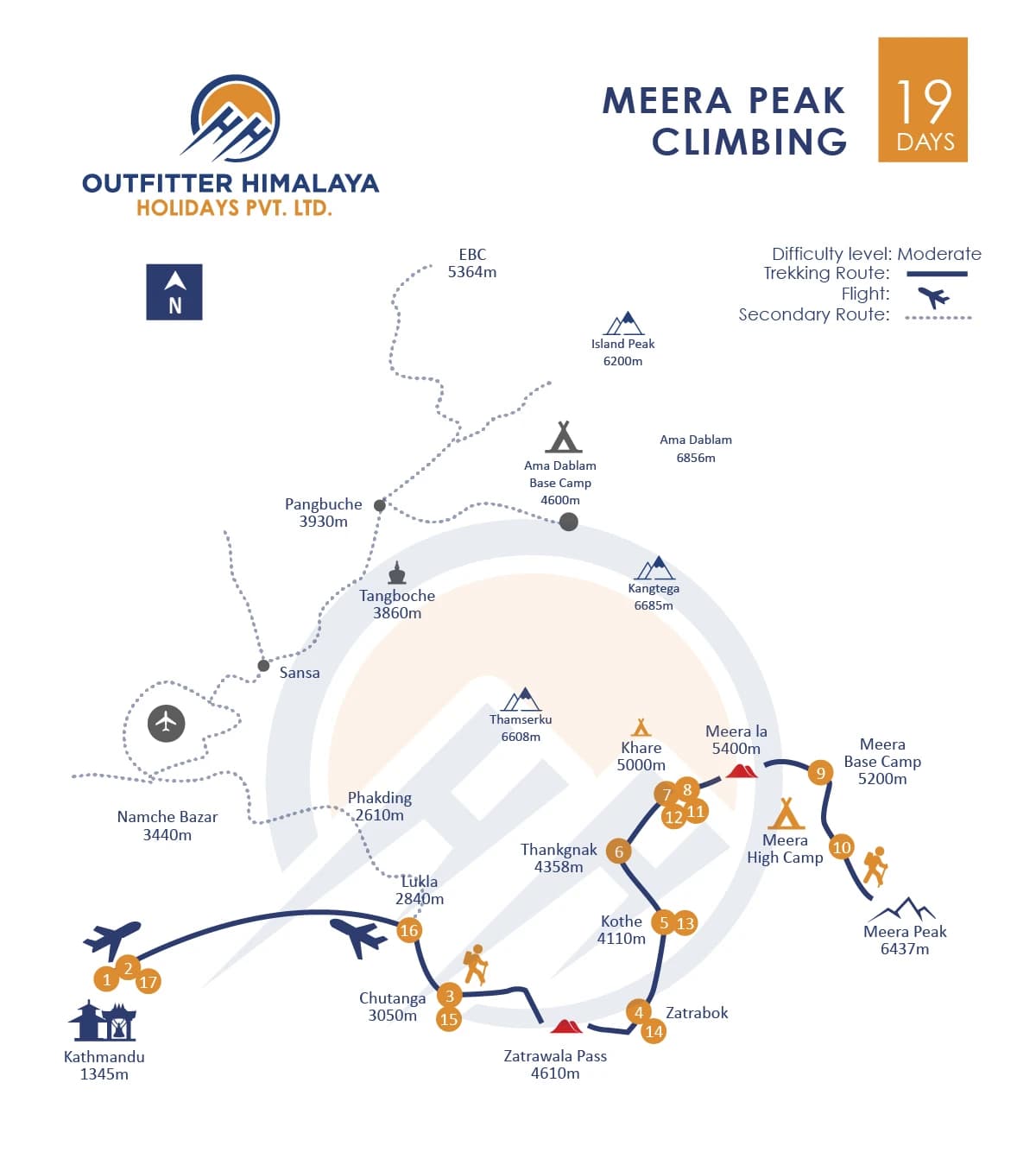
We will arrange an airport pick-up for your arrival at Tribhuvan International Airport.
You can meet our representatives at the terminal gate holding your name card. They will escort you to the hotel.
Feel free to ask them any questions you have. You will meet with the rest of the team members in the late evening.
A full-day tour in Kathmandu can include visits to various attractions in the city, such as historical temples, cultural sites, and local markets.
Some popular places in Kathmandu include the UNESCO World Heritage Site of Boudhanath, the Pashupatinath Temple, and the Kathmandu Durbar Square.
It is also possible to arrange a guided tour of the city to learn more about the history and culture of Kathmandu.
You meet with the guide and do last-minute shopping. We also arrange all the paperwork and permits.
The Mera peak climbing begins with a breathtaking short flight to Lukla from Kathmandu.
From Lukla, you will start trekking, accompanied by other group members. The trek involves ascending through small villages and forests. On the way, we'll cross suspension bridges over rivers. The trail can be challenging at times, with steep ascents and descents. Stay with the group and stay on the trail to avoid getting lost.
You will cross several streams and hamlets before arriving at the village of Paiya.
Leaving Paiya, the trail climbs steeply to the top of the Zatrawa la Pass, where we will enjoy spectacular views of several Himalayan peaks, including Kongde Ri, Numbur Himal, and Karolang Peak.
After enjoying the views from the top of the pass, the trail will continue on a relatively flat path for a short time before descending to the village of Panggom.
On this day, we trek to the village of Kothe. After a hearty breakfast, we'll begin the journey by descending steeply through a lush forest filled with rhododendrons and junipers.
The trail offers stunning views of the surrounding mountains, like Mera Peak and Nauleka Peak.
As we approach Kothe, the trail passes through various landscapes, from forests to open meadows.
After a quick breakfast, begin the trek for the day along the river bank. The trail will gradually ascend to Thangnak.
Along the way, we can see stunning Himalayan Mountains, including Kusum Kanguru Peak.
Today, we trek following the east route leading up to Khare village. We'll walk through the moraine, from which the view of Sabai Tso glacial lake is outstanding.
Once we reach Khare, The breathtaking views of the north face of Mera Peak and the Mera Glacier will greet you.
The trek from the previous village to Khare will likely take several hours and may involve some steep ascents and descents.
Today is a day to rest and acclimatize before ascending to Mera Peak base camp.
Since we have already gained a significant elevation, taking a break and allowing our body to adjust to the high altitude is essential to avoid altitude sickness.
During the rest day, we may explore the village or take a short hike to a nearby area.
The Acclimatization will allow us to enjoy the beauty of the surrounding landscape and exercise while giving our bodies the time they need to acclimate.
Listen to your body, and do not push yourself too hard today. Proper Acclimatization is crucial for successful and safe climbing.
We leave Khare in the morning and gradually begin climbing towards the base camp of Mera Peak. The trail slowly ascends to the glacier's crest.
The path becomes relatively flat from here, leading to Mera La Pass at 5,400 meters (17,717 feet).
Along the way, we will have the opportunity to relish the breathtaking views of the surrounding mountains. We may also cross a few crevasses before reaching the base camp.
From the Mera base camp, we walk on Mera Glacier to reach the Mera high camp. The trail ascends along thick snow blankets.
On the way, we can see spectacular views of the Himalayan mountains, such as Makali, Baruntse, Everest, and Kusum Kanguru.
Likewise, the view of Mera Glacier is magnificent.
Today is a big day as we push toward the summit of Mera Peak. After carefully checking the weather conditions, we ascend toward the top at dawn, around 2:00 AM to 3:00 AM.
As we climb, we can see the central summit above the head of a vast glacier flanked by two ridges.
We climb across an open snowfield and cross over crevasses. The route will take us southeast, skirting below and to the east of the left-hand ridge before turning back towards the main summit ridge of Mera.
There are three summits on Mera Peak, and we will attempt to reach the highest one.
Following a classic snow ridge, we climb just below the final wall guarding the top. From there, we push to the summit and enjoy the breathtaking views.
After enjoying the views, we descend back down to the village of Khare for the night.
An extra day or two in our itinerary is always good if we encounter delays or unexpected issues, such as bad weather or other unforeseen circumstances.
Suppose everything goes according to plan, and we complete the climbing of Mera Peak as scheduled.
In that case, we'll have an extra day to spend in Kathmandu or explore other areas of the region.
Today, we will descend from the village of Khare and pass through the small town of Thagnak. From there, retrace your steps along the same path you took to reach this point.
We trek through the lush forests filled with fir, rhododendron, pine, and juniper trees and eventually reach the village of Kothe.
The journey from Khare to Kothe will likely take several hours and may involve some steep ascents and descents.
After a hearty breakfast, begin the trek for the day by leaving the village of Kothe and ascending on a steep path toward Zatrabok.
Walking along the trail, we will pass through dense forests and small settlements.
The path continues to Chutanga, where we must climb several times before reaching our destination.
The trail passes through forests and small villages and follows a rocky path. Along the way, we witness stunning mountain landscapes.
Leaving Chutang, we walk through dense forests and continue downhill to Lukla. Mountains like Numbur Himal, Khumbila, Kongde Ri, etc., decorate the path.
This route is the same one we have been following. Upon arriving in Lukla, we celebrate our successful summit and spend the final day relaxing and relishing the views.
After having breakfast on the trek, we will fly back to Kathmandu. The flight is short and offers picturesque views.
Upon landing at Kathmandu airport, we will transfer to your hotel. The remainder of the day is yours to relax and explore the area at your leisure.
Visit local attractions and wander through the bustling streets of Thamel. You can also purchase souvenirs to take home.
We can arrange a guided sightseeing tour of Bhaktapur and Patan if you are interested.
*Note: If flights to Lukla are delayed or cancelled due to adverse weather conditions in the mountains, you will have an additional free day to use on the trek.
On the trip's final day, we will provide transportation to the Tribhuvan International Airport for your departure.
Our team will assist you with checking out and handling your luggage.
- Airport transfers on arrival and departure
- Four-night hotel accommodation in Kathmandu with breakfast
- Teahouse accommodation during the trek and tented accommodation during the climb
- All meals (breakfast, lunch, and dinner) during the trekking and climbing
- Domestic flights (Kathmandu- Lukla - Kathmandu) with domestic airport tax
- English-speaking trekking guide, climbing guide ( for summit), and porters
- All necessary paper works, National park entry permits, climbing permits, Khumbu Pasang Lhamu Fee, and TIMS
- Salary, food, drinks, accommodation, transportation, and insurance for the guides and porters
- Arrangement of emergency helicopter service, which your travel insurance company will pay
- Sleeping bag, down jackets, and duffel bag, if Necessary (return after the trek)
- Seasonal fruits after dinner while on the Trek
- Trip completion certificate, if you need
- T-shirt and trekking map
- A farewell dinner
- First Aid and oximeter
- Official expenses and service charge
- Nepal Entry visa fee
- Travel insurance (compulsory)
- Meals (Lunch and Dinner) while you are in Kathmandu
- Your personnel expenses/shopping
- All the alcoholic and non alcoholic drinks
- Entrance fee on Kathmandu tour (Approx Nrs 2600.00)
- Sweet things like chocolate bars and bar bills
- Hot shower, internet, telephone, and laundry
- International airfare to and from Nepal
- Tips for the guide and staff
- Anything not mentioned in the included section
Are the dates offered unsuitable, or do you want to take a private trip? Check availability for your date.
Mera North climbing history
The French climbers Marcel Jolly, G. Baus, and L. Honills first summited Mera North in 1975. Compared to Mera Central and Mera West, the north summit route is less technically challenging and best for beginner climbers.
Mera peak climbing difficulty
The participants do need to have previous climbing experience. Still, they must be physically and mentally strong enough to climb the peak. The venture crosses several high mountain passes and involves steep trekking routes.
The distance you'll cover during the Mera peak climbing is 125 km. There will be walking on rugged paths, steep slopes, moraines, glaciers, and snowy blankets. To reach your next destination, you must trek for at least 5 hours daily. The limited tourist facilities along the way increase the challenges.
Altitude Sickness during the Mera Peak Expedition
The risk of altitude sickness is relatively high during Mera peak climbing. Our Mera peak itinerary is well designed, so you will not ascend more than 500 meters daily and take ample acclimatization days between the trek.
Even with all the precautions, you may see symptoms of altitude sickness, which are headache, breathing issues, vomiting, insomnia, nausea, etc.
But do not worry; our trained and experienced Sherpa guide will help you overcome the symptoms and ensure your safety on the mountain.
Drink plenty of water. Staying hydrated and eating lots of good food are key to maintaining energy. Avoid alcoholic drinks and smoking while on the way to Mera Peak.
Preparation for Mera peak climbing
Mera peak climbing demands you to be physically fit before you hit the trail. Even though there is no technical climbing involved in the journey, you have to be strong enough to walk long hours and face all the hurdles this extreme environment may emanate.
To prepare for the 19-day climb of Mera Peak, you must strengthen your core and work on your stamina.
- Hit the gym, do cardio, take short hikes, and walk regularly with a backpack. Train your legs and overall body.
- Activities like running, swimming, and cycling will help you build stamina. Train your mind to accept less service and simple accommodations.
Best time to go on Mera Peak Climbing
Spring season (March to May) and autumn (September to November) are the most ideal times to climb Mera Peak. These two seasons are considered the best for climbing peaks in the Himalayas because of the stable weather and moderate climate. The clear, bright sky and outstanding views make the journey pleasant.
Meals and Accommodation during Mera Peak climbing
Teahouse and camping are the main modes of accommodation in Mera peak climbing. Teahouses are available in the villages. The rooms are made with two beds and a few other pieces of furniture.
You can find a hot shower facility in some places, but you might have to pay a few extra bucks. While climbing, you stay overnight in high-quality tents provided by the company. Other tents, like dining tents and washroom tents, are also offered.
Meals are served as per the teahouse menu during the trek. Dishes like rice, curries, bread, veggies, meat, eggs, porridge, momo, noodles, sandwiches, etc can be seen on the menu.
You can also expect to see Tibetan dishes. Likewise, you can buy snacks from tea shops. During camping, all the meals are cooked by the crew members. We offer you delicious and nutritious meals.
Mera Peak Climbing Permits
You need permits to climb Mera Peak, which include a Mera Peak climbing permit, Sagarmatha National Park entry permits, TIMS (Trekkers information management system), and an entry permit from Khumbu-Pasang Lhamu Rural Municipality. Once you book the Mera Peak climbing with us, we apply for and obtain all these permits.
Travel insurance for Mera Peak Climbing
You need travel insurance that covers emergency evacuation by helicopter for the Mera peak climbing. The Mera peak climbing involves high-altitude Mountains. There is always a risk of AMS, and you may have to be evacuated in case of an emergency. And the cost of evacuation in Nepal is high. Make sure that your policy covers all these expenses in emergencies.
Useful Information for trekking and Climbing in Everest
- Packing Guide for Peak Climbing in Nepal
- Sagarmatha National Park
- Best time to Visit Everest Region
- Food and Drinks available in Everest Region
- Accommodation available in Everest Region
- Weather and temperature in Everest Region

